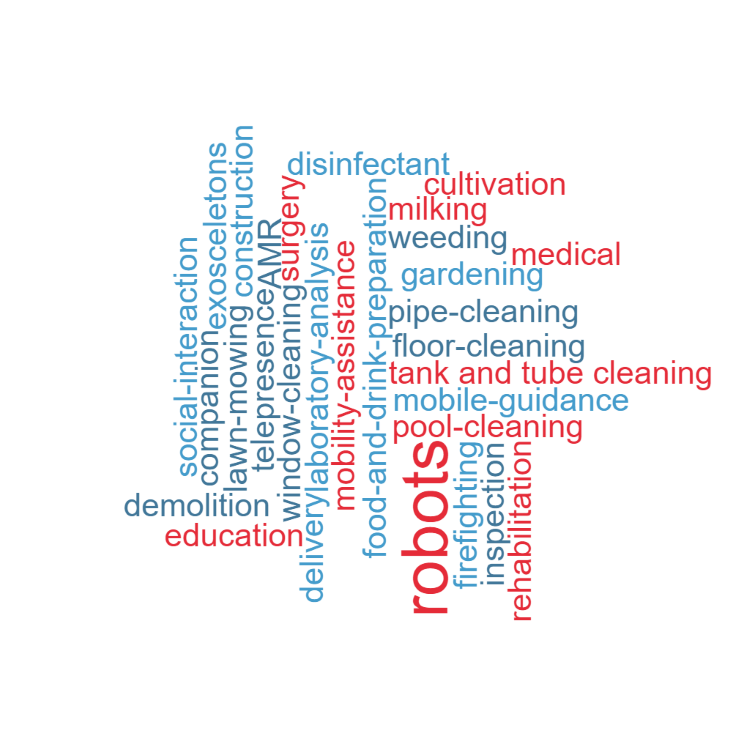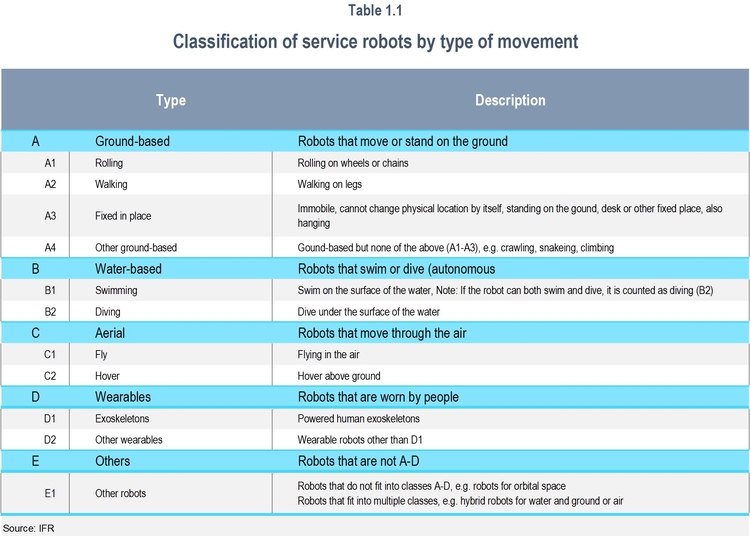
Service robots for commercial and private use are recording impressive growth rates in revenue and unit sales and have the potential to help master societal challenges. The World Robotics - Service Robots is an annual market report compiled by IFR statistical department jointly with Fraunhofer IPA.
What is a Service Robot?
- A service robot is an actuated mechanism programmable in two or more axes, moving within its environment, to perform useful tasks for humans or equipment excluding industrial automation applications.
- A service robot is a robot that does not produce anything.
- In some applications, manually controlled robotic devices with limited or even without autonomy are included. This is particularly relevant if legal requirements prohibit autonomy (e.g. surgery robots) or the purpose of the application requires only limited autonomy (e.g. assistance robots for disabled people).
- A consumer service robot is a service robot built for use by everyone. Neither operation nor setup require a professionally trained operator.
- A professional service robot is a service robot built for use by trained professional operators.
- Autonomous mobile robots (AMR) are professional service robots. If they are equipped with a manipulator, the manipulator is separately counted as an industrial robot.

World Robotics Service Robots at a glance
- Market data on service robots by application and region
- In World Robotics 2024 also by type of movement
- Extensive list of all service robot manufacturers known to the IFR
- Individual chapters with in-depth analysis of service robot applications are written in collaboration with Fraunhofer IPA
- Two completely revised chapters in each issue
- Focus applications in World Robotics 2023 were Agriculture and Medical Robots.
- New focus topics for 2024 are Outdoor Transportation without Public Traffic and Social Interaction
- Expert interviews with service robot suppliers on challenges and market entry hurdles
- The World Robotics 2023 featured interviews with Naio, Innok, Burro, and UVD Robots from Blue Ocean Robotics.
Highlights from past interviews
- INTERVIEW WITH NAÏO TECHNOLOGIES (Gaëtan Severac, Co-Founder):
Why did you choose to develop robots for the agricultural sector?
I founded Naïo Technologies 11 years ago with my co-founder Aymeric Barthes. We both have a technical background, both came from robotics, and Aymeric actually grew up on a farm. The main trigger was that 11 years ago we kept hearing from farmers that they were running out of labor. Even then, there was a shortage of skilled workers, even if it was not as acute as it is today. Also, at Naïo Technologies, we are convinced that we need to make agriculture a sustainable production system with the help of robots. - INTERVIEW WITH INNOK ROBOTICS (Helmut Schmid):
What are the biggest hurdles for bringing your robots to market?
There are certain difficulties, such as CE certification and risk analyses. These are not barriers, but they are definitely challenges in the regulations that can represent small pitfalls. From my point of view, however, it is much more important to inform the customers. Unlike in industry, for example in the automotive or electronics industry, our customers are not familiar with robotics. For this group of customers, robotics must not be a deterrent, i.e. not viewed as a complicated system, but must be operable by everyone. One way to reduce the entry barrier can be service models, such as robotics as a service. - INTERVIEW WITH BURRO (Charles Andersen, CEO):
What are currently (2023) the biggest challenges and what will the biggest challenges be in the next five years?
Challenges with our product often reside in the nature of the application. Precisely because our products are used in so many applications and scenarios, our customers often use them for use cases other than those for which we originally intended them. Of course, this provides us with very interesting insights into new areas of application, but it also naturally poses particular challenges for further development and maintenance. - INTERVIEW WITH UVD ROBOTS (Claus Risager, founder and CSO):
How are you planning to further develop your products to tackle these challenges?
The key thing for our progress lies in enhancing the intelligence of the robots, enabling us to tailor their disinfection capabilities to target, for example, specific pathogens, regardless of whether they are in a spore or live microorganism state.
IFR Classification Scheme of Service Robots
- Numbers are for units sold and Robots as a service (RaaS fleet) and provided by service robot suppliers worldwide.
- Classification by application and region.
- The IFR distinguishes broadly between service robots for professional use and for consumer use as well as medical robots.
- Service robots for consumer use do not require specific training. Examples are domestic cleaning robots, automated wheelchairs, and social interaction robots. In contrast, professional service robots require a professionally trained operator. Examples are cleaning robots for public places, delivery robots, fire-fighting robots, rehabilitation robots and surgery robots in hospitals.
- The category of professional service robot applications uses eight different application groups plus “other professional service robots” which is the appropriate class for all service robots that do not fit into any other class.
Agricultural Robots: In times of climate change, extreme weather events, and declining insect biomass the ever-increasing challenge of feeding the growing number of people on our planet can no longer be met without considering the ecological footprint. Agricultural robots are contributing to alleviate both the skill shortage and the ecological impact of modern agriculture.
Professional Cleaning: Cleaning robots and disinfectant robots have become increasingly popular with the Covid-19 pandemic. Reding human labor wherever possible and cleaning and disinfecting large surfaces can help to contain infections effectively.
Inspection and maintenance: Robots can go where people can’t, whether it’s the deepest ocean or the highest mountain. They can take over inspection and maintenance tasks in harsh conditions and dangerous places.
Construction and demolition: Construction of buildings or their demolition has traditionally required labor-intensive work. Skilled labor shortage however is becoming more and more of a challenge. New mobile robots which can be used for construction documentation, transport, 3D printing, drilling or even welding are faster and less exposed to weather conditions than human labor.
Logistics and Transportation: Automated guided vehicles are increasingly equipped with autonomic robotic capabilities and thus form one of the most prospering fields in service robotics. They are already widely used in logistics and warehouses. Numerous start-ups are working on the autonomous last mile delivery.
Search and Rescue: Natural disasters like earthquakes or fires still pose a big threat to humankind. Robots can help to save humans from these incidents.
Hospitality: Both the Covid-19 pandemic and current labor shortages have driven the demand for food and drink preparation robots as well as social interaction robots providing mobile guidance in retail stores, museums, and other public spaces. - In the segment of consumer robots, there are three major application groups plus robots that are intended for consumer use but do not fit into the major applications are classified under “other consumer robots”.
Domestic tasks: Robots for domestic use comprise robots for floor and window cleaning, for lawn mowing, cleaning of grills, and pools.
Social interaction and education: These social robots have gained significance during the Covid-19 pandemic and the social distancing measures imposed in most countries. The general idea of educational robots is to provide a platform for experimenting with robot without having to obtain a professional level of robot expertise first.
Care at home: Robots in this application group aim to help people who have age-related constraints or disabilities by providing mobility and manipulation assistance. - Medical Robots is now a third application area next to industrial and service robots. Robots can assist medical staff not only in the established field of surgery but also in care tasks and rehabilitation.





